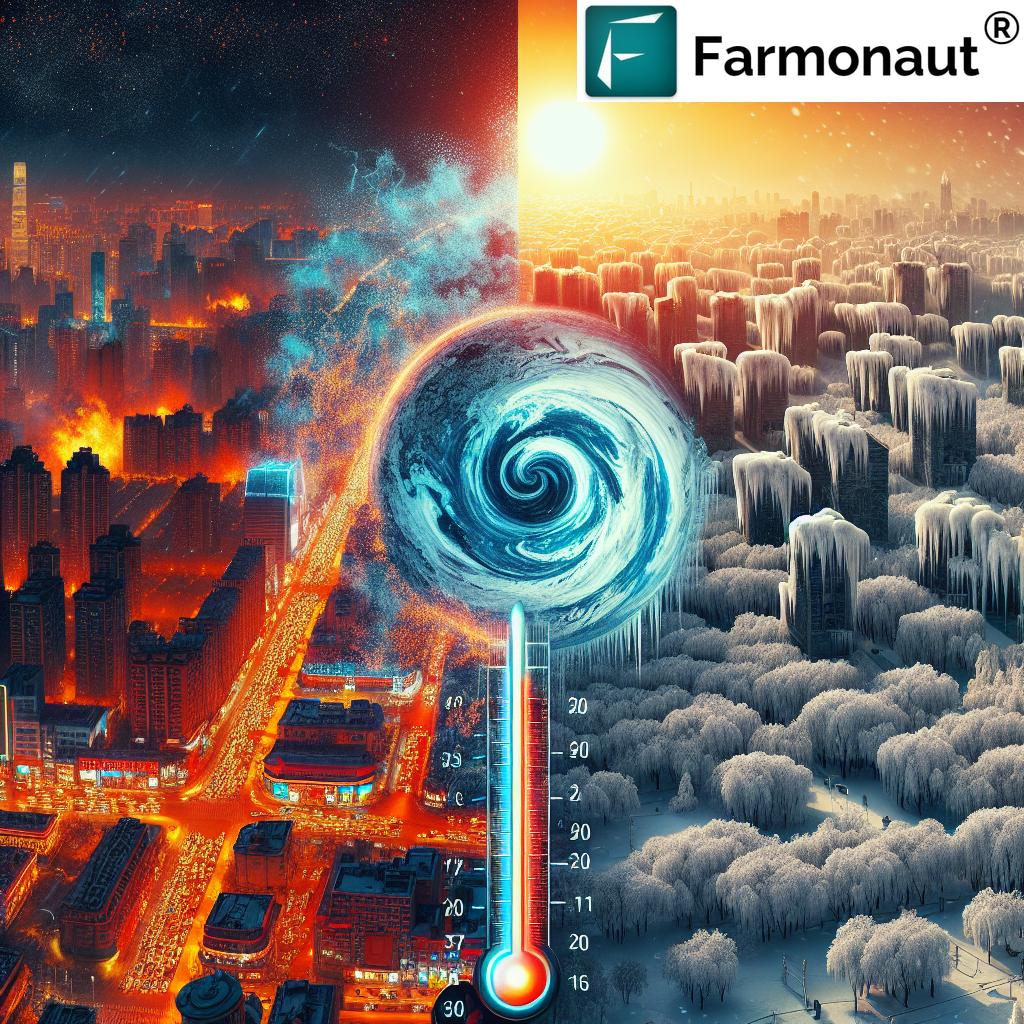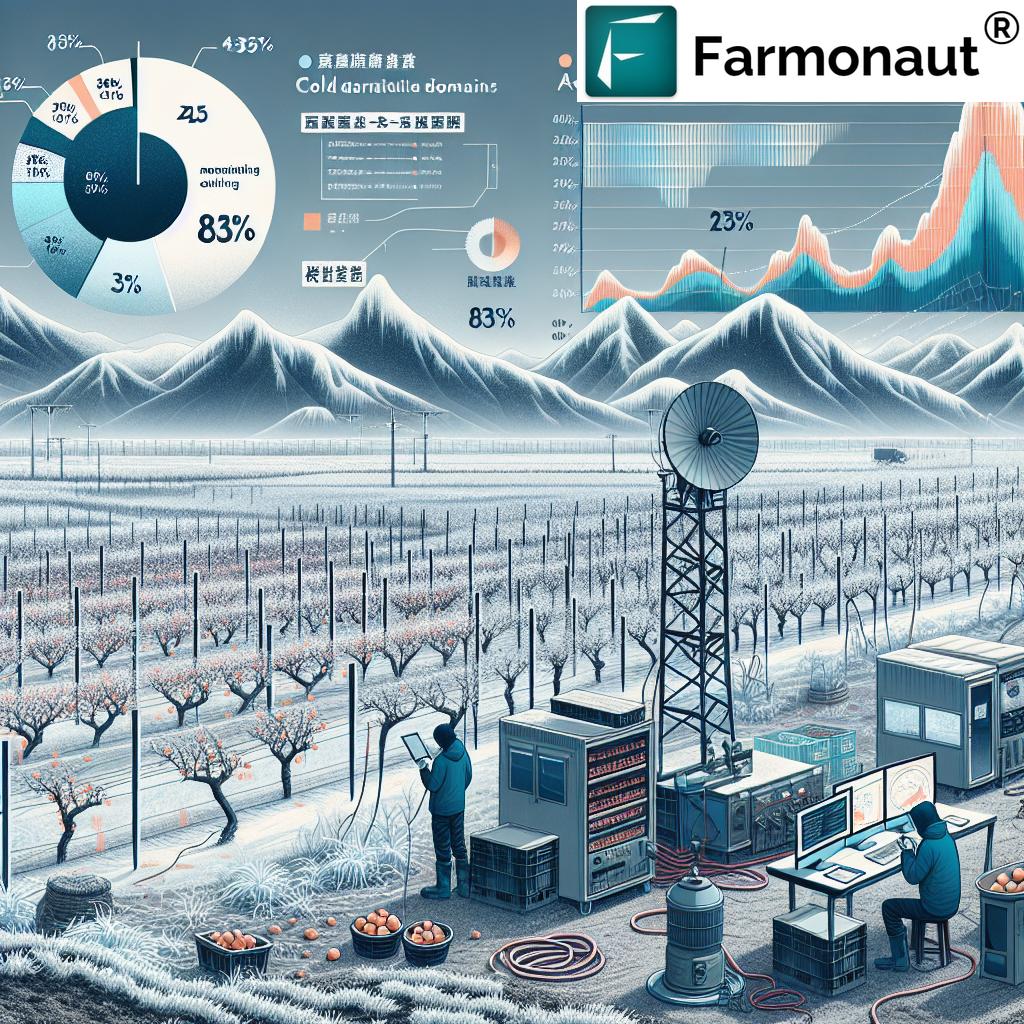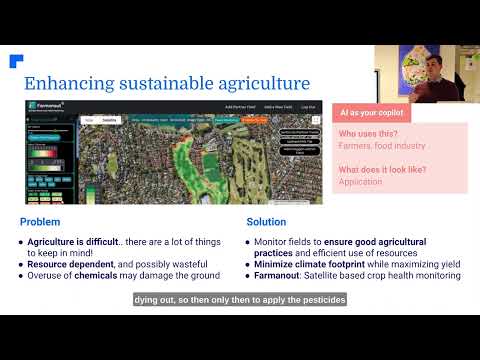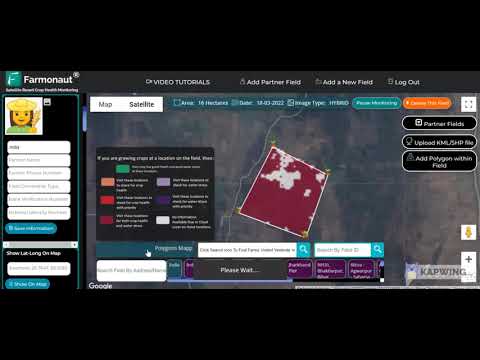Climate Change Paradox: How Global Warming Affects Extreme Cold Events in Eastern China
“Climate change reduced the severity of an extreme cold event in eastern China by 22%, while unusual wind patterns accounted for 83% of its intensity.”
As we delve into the complex world of climate change and its far-reaching impacts, we find ourselves facing an intriguing paradox. Despite the overall warming trend our planet is experiencing, certain regions are still susceptible to extreme cold events. This phenomenon has caught the attention of researchers and climate scientists worldwide, prompting a closer examination of the intricate relationship between global warming and localized weather patterns.
In this comprehensive analysis, we’ll explore a recent study that sheds light on an unexpected extreme cold event in eastern China, occurring in December 2023. This event, which caused significant disruptions and agricultural damage, offers valuable insights into the evolving nature of our climate and its implications for future weather patterns.
Understanding the Climate Change Paradox
The occurrence of extreme cold events in a warming world may seem counterintuitive at first glance. However, it’s essential to recognize that climate change doesn’t simply mean uniform warming across the globe. Instead, it leads to complex alterations in atmospheric circulation patterns, which can result in seemingly paradoxical weather events.
To better understand this phenomenon, let’s break down the key elements of the study conducted by researchers from the Chinese Academy of Sciences and the University at Albany:
- The extreme cold event in eastern China occurred in December 2023, one of the warmest years on record.
- The event caused transportation shutdowns, power supply shortages, and significant agricultural damage.
- Researchers used a combination of historical weather data and climate simulations to analyze the event’s causes and implications.
The Role of Atmospheric Circulation Patterns
One of the most striking findings of the study was the significant role played by unusual large-scale atmospheric circulation patterns in driving the extreme cold event. These wind patterns accounted for a staggering 83% of the event’s intensity. This revelation underscores the importance of understanding and monitoring atmospheric dynamics in predicting and preparing for extreme weather events.

Atmospheric circulation patterns are complex systems of wind movements that distribute heat and moisture around the globe. Changes in these patterns can lead to the displacement of cold air masses, sometimes bringing Arctic air to lower latitudes. In the case of the eastern China event, an unusual configuration of these patterns resulted in the southward push of frigid air, causing the extreme cold wave.
The Mitigating Effect of Global Warming
While the atmospheric circulation patterns were the primary driver of the cold event, the study also revealed an interesting counterbalance: the warming effect of climate change actually reduced the event’s severity by up to 22%. This finding highlights the complex interplay between global warming trends and localized extreme weather events.
The reduction in severity can be attributed to several factors:
- Overall increase in global temperatures, which can soften the impact of cold air masses
- Changes in the jet stream patterns due to Arctic warming
- Alterations in the frequency and intensity of weather systems
This mitigating effect of global warming on extreme cold events presents a nuanced picture of climate change impacts. While it may seem beneficial in this context, it’s crucial to remember that global warming also exacerbates other types of extreme weather events, such as heatwaves, droughts, and intense storms.
Future Projections: A Changing Landscape of Extreme Events
“Future projections indicate extreme cold events in eastern China will become rarer and milder by the end of the 21st century.”
Looking ahead, the research team used advanced climate simulation techniques to project future trends in extreme cold events for eastern China. Their findings paint a picture of significant changes by the end of the century:
- The likelihood of similar cold events has already dropped by over 92% compared to a world without current global warming trends.
- The intensity of these events has decreased by 1.9 degrees Celsius.
- By the end of the century, such events are projected to become even rarer, decreasing in frequency by 95%.
- The intensity of these events is expected to decrease by more than 2 degrees Celsius.
These projections suggest a future where extreme cold events in eastern China become increasingly rare and less severe. However, it’s important to note that this doesn’t mean such events will disappear entirely. The climate system is complex and dynamic, and localized factors can still lead to occasional cold snaps.

The Broader Context: Climate Change and Extreme Weather
While the study focuses on extreme cold events in eastern China, it’s essential to consider these findings within the broader context of global climate change. As we’ve seen, warming trends can have paradoxical effects on certain types of extreme weather. However, the overall impact of climate change on weather patterns is far-reaching and often intensifies other types of extreme events.
Here’s a comparative analysis of how climate change is affecting different types of extreme weather events in eastern China:
| Weather Event Type | Current Trend (estimated frequency per decade) | Projected Trend by 2100 (estimated frequency per decade) |
|---|---|---|
| Extreme Cold Waves | Decreasing (3-5 events) | Rare (0-1 events) |
| Wildfires | Increasing (5-7 events) | Significantly higher (10-15 events) |
| Severe Storms | Increasing (8-10 events) | Substantially higher (15-20 events) |
This table illustrates the shifting landscape of extreme weather events in eastern China. While cold waves are becoming less frequent, other types of extreme events are on the rise. This changing pattern of weather extremes poses new challenges for agriculture, infrastructure, and human health.
Implications for Agriculture and Food Security
The changing patterns of extreme weather events have significant implications for agriculture and food security in eastern China and beyond. While the reduction in extreme cold events may benefit some crops by extending growing seasons, the increase in other types of extreme weather poses new challenges for farmers and agricultural planners.
Here are some key considerations:
- Changing planting and harvesting schedules to adapt to new weather patterns
- Developing crop varieties that are resilient to a wider range of weather conditions
- Implementing advanced irrigation and water management systems to cope with increased drought risk
- Enhancing pest and disease management strategies as warmer conditions may favor certain agricultural pests
In this context, precision agriculture tools and technologies play a crucial role in helping farmers adapt to changing climate conditions. Platforms like Farmonaut offer valuable solutions for monitoring crop health, optimizing resource use, and making data-driven decisions in the face of evolving weather patterns.
The Role of Technology in Climate Adaptation
As we navigate the complexities of climate change and its impacts on agriculture, technology emerges as a powerful ally. Advanced tools and platforms are enabling farmers and researchers to better understand, predict, and respond to changing weather patterns and their effects on crop production.
Some key technological advancements in this area include:
- Satellite-based crop monitoring: Platforms like Farmonaut use multispectral satellite imagery to provide real-time insights into crop health, soil moisture, and other critical metrics. This data helps farmers make informed decisions about irrigation, fertilizer use, and pest management, even as weather patterns become less predictable.
- AI-driven advisory systems: Advanced algorithms can analyze historical weather data, current conditions, and future projections to provide personalized recommendations for crop management. These systems help farmers adapt their practices to changing climate conditions.
- Precision agriculture tools: Technologies such as GPS-guided machinery, drone-based imaging, and IoT sensors enable more precise and efficient use of resources, helping farmers maintain productivity in the face of climate challenges.
- Climate-smart agriculture practices: Innovative farming techniques, supported by technology, can help mitigate the impacts of climate change while improving resilience and productivity.
By leveraging these technologies, farmers and agricultural stakeholders can better prepare for and adapt to the changing landscape of extreme weather events.
Explore Farmonaut’s API for advanced agricultural data
The Importance of Ongoing Research and Monitoring
The study on extreme cold events in eastern China underscores the importance of continued research and monitoring of climate change impacts. As our understanding of these complex systems evolves, we can better predict and prepare for future challenges.
Key areas for ongoing research include:
- Refining climate models to improve long-term weather predictions
- Studying the interactions between different climate systems and their effects on local weather patterns
- Assessing the impacts of climate change on various sectors, including agriculture, energy, and public health
- Developing and testing new adaptation strategies for different regions and industries
This ongoing research is crucial for informing policy decisions, guiding adaptation strategies, and helping communities prepare for the challenges ahead.
Preparing for a Changing Climate: Strategies for Resilience
As we face the realities of a changing climate, it’s crucial to develop and implement strategies for building resilience across various sectors. Here are some key approaches:
- Diversification of crops and farming practices: Encouraging farmers to grow a variety of crops and adopt diverse farming techniques can help spread risk and improve overall resilience to extreme weather events.
- Investment in infrastructure: Developing climate-resilient infrastructure, such as improved water management systems and more robust transportation networks, can help communities better withstand and recover from extreme weather events.
- Early warning systems: Enhancing our ability to predict and communicate about impending extreme weather events can help communities prepare and minimize potential damages.
- Sustainable land use practices: Implementing practices that promote soil health, reduce erosion, and enhance natural ecosystems can improve overall resilience to climate impacts.
- Continuous education and training: Keeping farmers, policymakers, and the general public informed about the latest climate science and adaptation strategies is crucial for building a resilient society.
By implementing these strategies and continuously adapting to new information and challenges, we can work towards a more resilient and sustainable future in the face of climate change.
Check out Farmonaut’s API Developer Docs for integration insights
The Global Context: Lessons from Eastern China
While this study focuses on eastern China, its findings have implications for our understanding of climate change impacts globally. The paradoxical effects of global warming on extreme cold events highlight the complexity of climate systems and the need for nuanced, region-specific approaches to climate adaptation.
Some key takeaways for global climate change understanding include:
- The importance of considering both global trends and local factors in climate impact assessments
- The potential for unexpected or counterintuitive climate change effects in different regions
- The need for flexible and adaptive approaches to climate change mitigation and adaptation
- The value of international collaboration in climate research and data sharing
By studying specific regional impacts, like those observed in eastern China, we can gain insights that inform global strategies for addressing climate change and its diverse effects.
The Role of Technology in Climate Change Adaptation
As we confront the challenges posed by climate change, technology emerges as a crucial tool for adaptation and resilience. Advanced platforms and solutions are enabling farmers, researchers, and policymakers to better understand, predict, and respond to changing weather patterns and their effects on various sectors, including agriculture.
Farmonaut, a leading agricultural technology company, offers innovative solutions that address many of the challenges highlighted in this study. By leveraging satellite imagery, artificial intelligence, and machine learning, Farmonaut provides farmers with valuable insights and tools to navigate the complexities of a changing climate.
Key features of Farmonaut’s platform include:
- Real-time crop health monitoring: Using multispectral satellite images, Farmonaut provides up-to-date information on vegetation health, soil moisture, and other critical metrics. This data helps farmers make informed decisions about irrigation, fertilizer usage, and pest management, even as weather patterns become less predictable.
- AI-driven advisory system: Farmonaut’s Jeevn AI analyzes satellite data and other inputs to generate customized advice for farmers, improving farm productivity and efficiency in the face of changing climate conditions.
- Weather forecasting and historical data: Access to accurate weather forecasts and historical data helps farmers plan their activities and make informed decisions about planting, harvesting, and resource management.
- Resource management tools: Farmonaut’s platform includes features for optimizing resource use, which is crucial as climate change alters the availability and distribution of water and other vital resources.
By providing these advanced tools at an affordable price point, Farmonaut is democratizing access to precision agriculture technologies, enabling farmers of all scales to adapt to climate change impacts more effectively.
Conclusion: Navigating the Climate Paradox
The study of extreme cold events in eastern China offers a fascinating glimpse into the complex and sometimes paradoxical effects of climate change. While global warming is reducing the frequency and intensity of these cold events, it’s simultaneously increasing the risk of other extreme weather phenomena. This research underscores the need for continued scientific inquiry, adaptive strategies, and technological innovation in our response to climate change.
As we move forward, it’s clear that a multifaceted approach is necessary to address the challenges posed by our changing climate. This includes:
- Continued investment in climate research and monitoring
- Development and implementation of adaptive strategies across various sectors
- Adoption of advanced technologies to improve resilience and resource management
- International collaboration to share knowledge and resources
- Public education and engagement to foster a collective response to climate challenges
By embracing these approaches and leveraging innovative solutions like those offered by Farmonaut, we can work towards a more resilient and sustainable future in the face of climate change. The paradox of extreme cold events in a warming world serves as a reminder of the complexity of our climate system and the importance of nuanced, data-driven approaches to climate adaptation.
FAQs
- Q: How can extreme cold events occur in a warming world?
A: While global average temperatures are rising, changes in atmospheric circulation patterns can still lead to localized extreme cold events. These events are becoming less frequent and less severe due to overall warming trends. - Q: What role do atmospheric circulation patterns play in extreme weather events?
A: Atmospheric circulation patterns distribute heat and moisture around the globe. Unusual configurations of these patterns can lead to extreme weather events, such as the cold wave observed in eastern China. - Q: How is climate change affecting the frequency of extreme cold events in eastern China?
A: According to the study, the likelihood of extreme cold events in eastern China has already dropped by over 92% compared to a world without current global warming trends. By the end of the century, such events are projected to become even rarer, decreasing in frequency by 95%. - Q: What are the implications of changing weather patterns for agriculture?
A: Changing weather patterns can affect planting and harvesting schedules, crop yields, and pest management strategies. Farmers may need to adapt their practices and consider new crop varieties to maintain productivity. - Q: How can technology help in adapting to climate change impacts?
A: Technologies like satellite-based crop monitoring, AI-driven advisory systems, and precision agriculture tools can help farmers make informed decisions, optimize resource use, and improve resilience to changing weather patterns.
Earn With Farmonaut: Affiliate Program
Earn 20% recurring commission with Farmonaut’s affiliate program by sharing your promo code and helping farmers save 10%. Onboard 10 Elite farmers monthly to earn a minimum of $148,000 annually—start now and grow your income!
Farmonaut Subscriptions
As we continue to navigate the complexities of climate change and its impacts on agriculture, tools like Farmonaut offer valuable support for farmers and agricultural stakeholders. By providing affordable access to advanced satellite monitoring and AI-driven insights, Farmonaut is helping to democratize precision agriculture and improve resilience in the face of changing weather patterns.







